| Token | Source | Date |

|

mꜣꜣ nḏ.t-ḥr jn.w n ḥw.wt njw.wt mḥ.w šmꜥ.w pr-ḏ.t
Seeing the gifts and tribute of the mansions and villages of lower and upper Egypt and the domain of eternity,
|
Asosi Djedkare
|

|

[...] t' wꜥb n(.j) pr mnṯ.w dbḥ.t-ḥtp m pr wsjr mrr.t ꜣḫ.w wn(m) jm n (j)m(.j)-r(')-sbꜣ.w mꜣꜥ.t(j) ḏd
[...] pure bread from the estate of Montu, a funerary meal from the estate of Osiris, in which the blessed spirits wish to eat, for the doorkeeper Maat(i), who says:
|
Intef III Nakhtnebtepnefer
|
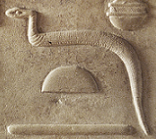
|

ḏd-mdw jn jmn-rꜥ kꜣ mw.t=f dj.n(=j) ns.yt tꜣ.wy ḥqꜣ.t jdb.wy n sꜣ n ẖ.t(=j) sn-wsr.t dj ꜥnḫ ḏd wꜣs mj rꜥ ḏ.t
Recitation by Amon-Re, bull of his mother. I have given the kingship of the two lands and the rulership of the two riverbanks to the son of my body, Senwosret, given life, stability and dominion, like Re, eternaly.
|
Senwosret I Kheperkare
|

|

ḏd mꜣꜥ.n wj ḥm n nb nṯr pn ḥr(.y)-tp tꜣ.wy wḏ kꜣ.t
saying: The majesty of the lord, this god, chief of the two lands, sent me, commanding the work
|
Senwosret I Kheperkare
|

|

sbk n pḥ.wy mw ḏd=f
Sobek of the back of the water, he says:
|
Senwosret II Khakheperre
|
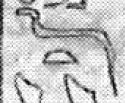
|

nfr bꜣḏ.ty bꜣ.w p
effective of the two dippers of the souls of Buto
|
Tuthmosis III Menkheperre (complete reign)
|

|

ḏfꜣ.w pr=f n ḏ.t m ḥḥ.w ḥfn.w m ẖ.wt
who provisions his house of eternity with millions and hundreds of thousands of things,
|
Amenhotep IV / Akhenaten Neferkheperure
|
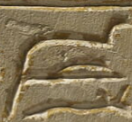
|

ḏd=f jnḏ-ḥr=k wbn m nwn sḥḏ tꜣ.w m-ḫ.t pr=f
He said : « Hail to you who rises in the Nun, who illumines the world when he comes forth.
|
Ramesses II Usermaatre-Setepenre
|
.JPG)
|

šnj.t nṯr šp tp=f šnj.t=ṯ ḏs=ṯ nn srq.t
the god, whose head is blind will be summoned; you yourself will be summoned here, scorpion.
|
26th Dynasty
|

|

ḏd=f jyj pw jr.n wr ꜥꜣ n nb n ḫꜣs.t nb(.t) kmbjṯt r km.t
He says: the king of the lord of every foreign land, Cambyses, came to Egypt
|
Cambyses Mestiure
|

|

ꜥbb nṯr.y m ḏ.t=f
the divine scarab in his body
|
Ptolemy XIII
|
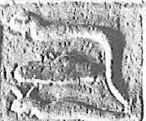
|

ḏd mdw jn rnn.wtt srq.t ḫsf ḏdf.wt ḥm.t nmt.t sn r [pr]-šps.t
Recitiation by Renenoutet-Serket, who opposes the snakes, who repels and strides through them to the house of the noble one.
|
Ptolemy XIII
|

|

ꜥšꜣ smn.w=f m ḏ.t=f ẖ.t=f ḏsr ḏ.t=f tp rnp.t n nḥb-k(ꜣw)
numerous are his shapes in the day and night, sacred is his body at the beginning of the year because of Nehebkau,
|
Ptolemy XIII
|
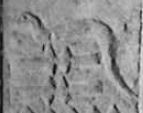
|

ḫpr ḏs=sn m ꜥḥꜥ.w jpn nfr.w wꜥ nb m ḏsr s.t
who came to be by themselves as these beautiful snakes, everyone as one who is sacred of place.
|
Ptolemy XIII
|
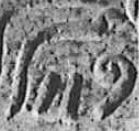
|

bꜣ n jtm.w dj=f s(w) m ḏ.t=f m jtn wr dj ḥḏḏ.wt pr=f m pr=f
The Ba of Atoum, he places him in his body as the great sun disk, which gives brightness while it goes forth from its house
|
Ptolemy XIII
|

|

ꜥnḫ=k n mꜣꜣ s(y) nn ḥr=s r=k km ḏ.t ḥtp ḥm=k
May you live because of seeing her, she will not be far away from you, completing eternity, while your majesty rests.
|
Cleopatra VII Philopator
|

|

m ḥḥ.w n(.w) n(y)-sw.t sqꜣ sw r km ḏ.t
as millions for the king, exalting him in order to complete eternity.
|
Cleopatra VII Philopator
|

|

wnn skr sꜣq m ḏ.t=f ḥqꜣ.t ḥnw wṯs ḥm=f m tꜣ
Sokar is gathered in his body, she who rules the Henu-bark, who lifts his majesty in the land.
|
Cleopatra VII Philopator
|

|

sꜣ ꜥnḫ wꜣs nb ḥꜣ=f mj rꜥ ḏ.t šny qr.ty ḏd kꜣ jmn wḏb.w
the protection of all life and dominion is behind him like Re, eternally, which encircles the twin caverns of the nile, enduring of the hidden kA and the riverbanks
|
Cleopatra VII Philopator
|

|

jn=f n=k jq ḏd.tw ẖr ḏ.t=k
He brings for you, the nome of the annihilated crocodile, stability under your body
|
Cleopatra VII Philopator
|

|

|
Augustus
|

|

ḏd jn wsjr ḫnt.y jmn.tyw nb ꜣbḏw sꜣ n wr tp n gbb wpj ḫ.wt nfr ḥr dj ꜥnḫ ḏd wꜣs nb snb nb ꜣw-jb nb n djw-ḥr nḥḥ ḏ.t jry
Spoken by Osiris, the formost of the westerners, the lord of Abidos, the firstborn son of Geb, who judges the cases, beautiful of face, who gives all life, stability and dominion, all health and all joy to Teüris, all eternity and forever.
|
Trajan
|